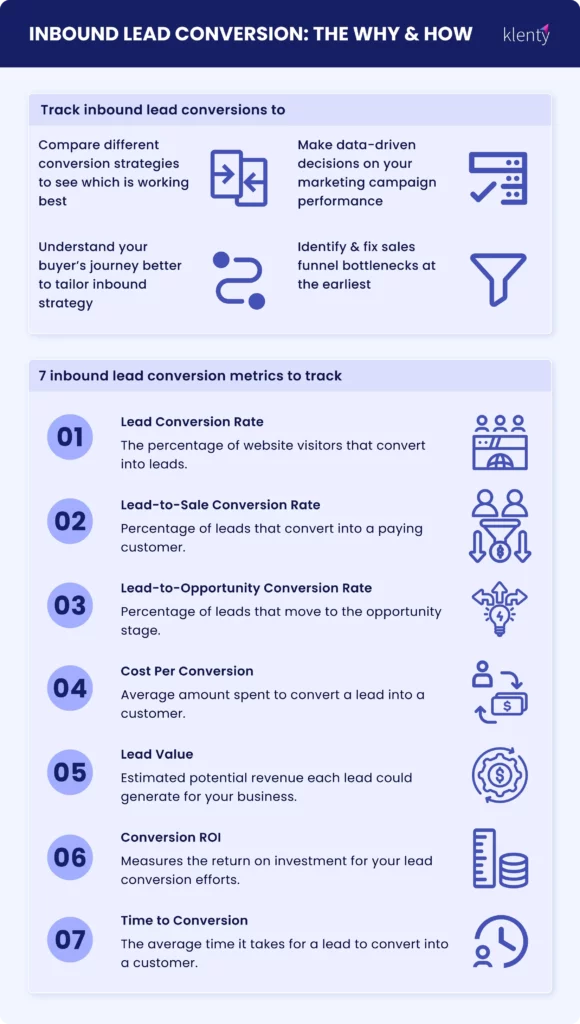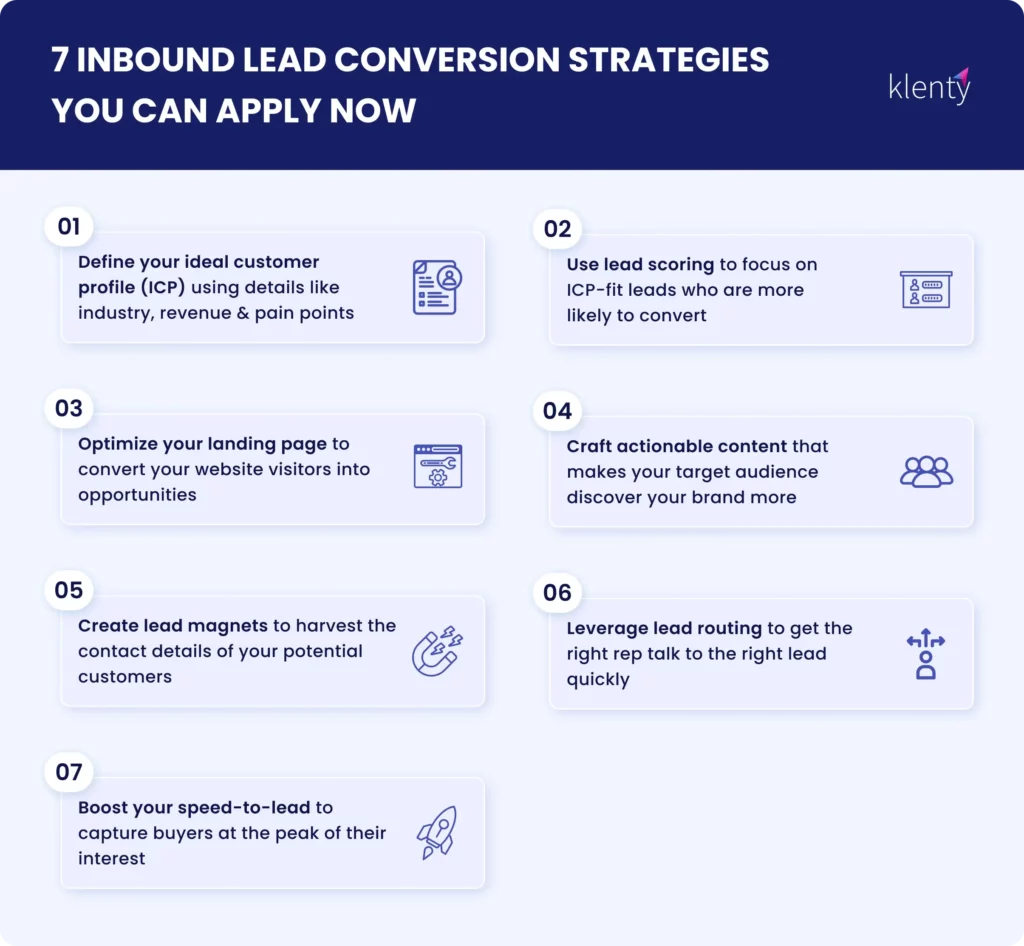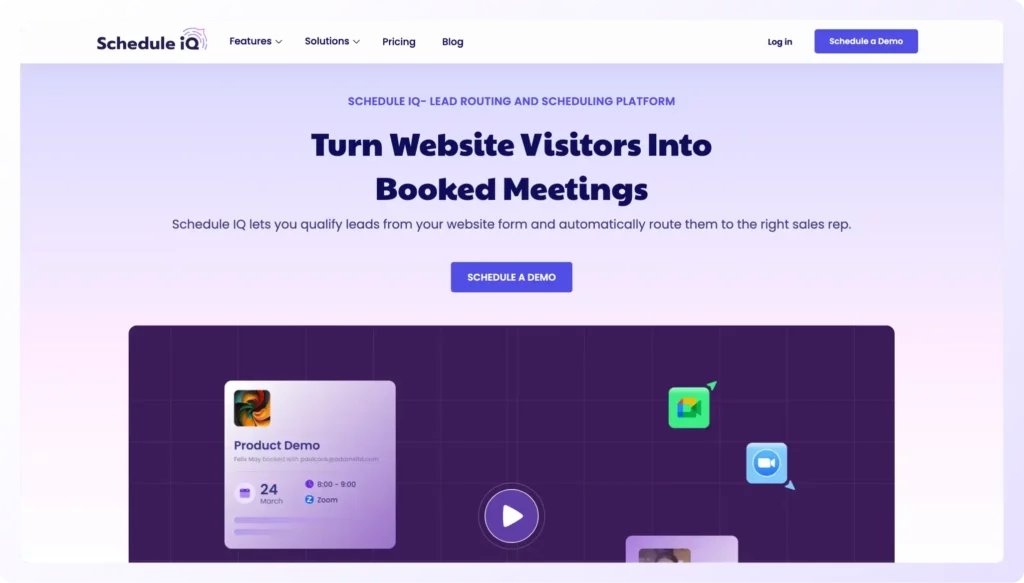Inbound lead generation is an essential aspect of any successful business. You need a steady stream of high-quality leads to ensure consistent revenue generation.
However, just getting leads isn't enough—you need to turn those leads into paying customers.
Without the right strategies in place, your lead conversion efforts can fall short, leading to fewer booked meetings and sign-ups. This can ultimately hurt your revenue and return on investment.
To bridge this gap, you need robust strategies up your sleeve that can transform inbound leads into loyal customers.
In this article, we will equip you with 7 killer strategies that will help you optimize your efforts and convert inbound leads.
What Is Inbound Lead Conversion?
An inbound lead is a potential customer who initiates contact with your business. They might show interest in your products through inbound marketing channels like blogs, landing pages, emails, social media posts, etc.
So, inbound lead conversion is the process of converting these inbound leads into paying customers. The process starts where lead generation ends and involves nurturing and guiding them through different stages of the sales funnel using targeted marketing and sales strategies.
Inbound lead conversion typically involves 3 key stages:
- General Lead to Marketing Qualified Lead (MQL). In the first stage, you evaluate a lead that has entered your system based on factors such as demographic and behavioral information to qualify them as Marketing Qualified Leads (MQLs). An MQL is a lead that matches one or more of your ideal buyer criteria but isn’t ready to buy yet.
- MQL to Sales Qualified Lead (SQL). Once you've identified your MQLs, your sales team reaches out to them through email or phone to determine their sales-readiness. If they're ready to make a purchase, they're qualified as SQLs and moved further down the sales funnel.
- SQL to Paying Customer. The last stage involves a pre-sales demo tailored to the prospect's goals and pain points, handling objections, negotiating, and closing the deal. Once they sign the contract, they become a paying customer.
Why Should You Track Inbound Lead Conversion?
Tracking inbound lead conversion is crucial as it impacts the effectiveness of your marketing and sales efforts. It helps you improve lead generation and boost revenue and is proven to be more effective than outbound lead conversion.
In fact, studies show that inbound practices generate 54% more leads than traditional outbound practices and cost 61% less per lead.
Here's why it's important to keep track of inbound lead conversions:

- Compare Different Conversion Strategies
Tracking inbound lead conversion helps you see which strategies are working best. By analyzing what's converting the most, you can focus on improving those strategies and tweaking the ones that aren't as effective.
For example, if you find that leads generated through your blog have a higher conversion rate compared to those from social media posts, you can allocate more resources to create valuable content and optimize SEO.
- See What's Working and What's Not
By tracking inbound lead conversions, you can determine which aspects of your marketing campaigns or sales processes are performing well and which aren't. This enables you to make data-driven decisions to enhance your overall conversion strategy.
For instance, if your webinars are converting more leads than eBook downloads, you can analyze this trend to understand if there are any similarities or patterns among the leads signing up for the webinar.
- Understand Your Buyer's Journey Better
Tracking lead conversion provides valuable insights into your buyer's journey. For example, you might find that leads from a particular source (say, content marketing) have a higher chance of converting if you follow up with them within 24 hours. This allows you to tailor your content strategies to boost conversion.
- Identify and Fix Bottlenecks Early
Regularly tracking conversions can help you pinpoint any bottlenecks or obstacles that might be holding back leads from moving through the sales funnel. For example, your demo scheduling process might be too complicated or your follow-up emails might not be compelling enough. By identifying these issues early, you can take steps to fix them, making the conversion process smoother and more efficient.
Now that you know why it's important to track inbound leads, the question arises - what exactly should you track? Here's a handy guide to the key inbound lead conversion metrics you should look out for:
- Lead Conversion Rate. This metric measures the percentage of website visitors that convert into leads. It's calculated by dividing the number of converted leads by the total number of website visitors, then multiplying by 100.
- Lead-to-Sale Conversion Rate. This metric tracks the percentage of leads that convert into a paying customer. It's calculated by dividing the number of converted leads by the total number of leads, then multiplying by 100.
- Lead-to-Opportunity Conversion Rate. This metric measures the percentage of leads that move to the opportunity stage in your sales funnel. It's calculated by dividing the number of leads converted into opportunities by the total number of leads, then multiplying by 100.
- Cost Per Conversion. This metric calculates the average amount you're spending to convert a lead into a customer. It's calculated by dividing the total marketing cost by the total number of converted leads.
- Lead Value. It estimates the potential revenue each lead could generate for your business. It's calculated by dividing the total sales value by the total number of leads in your pipeline.
- Conversion ROI. Conversion ROI measures the return on investment for your lead conversion efforts. It's calculated by subtracting the cost from the lead value and dividing it by the cost again.
- Time to Conversion. This metric tracks the average time it takes for a lead to convert into a customer. It's calculated by dividing the total time visitors spend on your website by the total number of leads.
Now that we've covered all bases about the what and why of inbound lead conversion, let's look at how you can boost your conversion rates.
Top 7 Strategies for Inbound Lead Conversion
Converting inbound leads into paying customers takes more than just getting prospects interested and collecting their contact information. It requires a strategic approach that involves nurturing relationships, providing valuable content, and guiding leads through each stage of the sales funnel.
Here are our top 7 expert strategies that'll help you do just that:

1. Define Your Ideal Customer Profile (ICP)
Before investing time and effort in a lead, make sure it’s worth your while. It's important to focus on sales-qualified leads that have higher chances of converting. For this, you need to define your Ideal Customer Profile (ICP).
An ICP is a detailed description of the type of customer that would benefit most from your product and bring the most value to your business. This involves identifying specific characteristics such as demographics, industry, company size, revenue, etc.
By knowing exactly who your ideal customer is, you can tailor your marketing strategies to resonate with the right audience. This way, instead of casting a wide net and crossing your fingers, you can focus on prospects who are more likely to convert.
Here's how you can define your ICP:
- Refer to Existing Customer Database. Start by analyzing your current customer database. Look at the demographics, behaviors, and purchase patterns of your existing customers.
- Make a List of Your Best Customers. Identify customers who are the most satisfied with your product and generate the most revenue.
- List Down Similarities. Look for patterns in their industry, company size, revenue, challenges, and budgets. This will help you identify key traits of your ideal customer.
- Create Your ICP. Use the data you've collected to create a detailed profile of your ideal customer, including details such as demographics, industry, revenue, budget, company size, challenges, and goals.
- Review and Refine. Continuously review and refine your ICP based on feedback and new data.
2. Use Lead Scoring To Qualify Leads
Lead scoring helps you evaluate and prioritize leads that are ready to move forward in the sales funnel. It assigns numerical scores to your leads on a scale ranging from newly interested leads to those who are ready to make a purchase.
With this strategy, you can focus on leads that are more likely to convert and use your time and resources effectively. You can assign scores based on:
- Demographic information such as company size, industry, or revenue.
- Engagement metrics such as website visits, email opens, or interactions on social media.
- Specific actions such as downloading a white paper, attending a webinar, or requesting a product demo.
You can assign scores to each attribute based on their importance and relevance to your business. For example, you may assign a higher score to a lead from a target industry than a lead from a non-target industry.
PRO TIP: Thanks to automation, you don't have to manually assign scores to each lead. You can simply automate the process to score leads in real time based on the latest interactions and data.
3. Optimize Your Website Landing Page
Your landing page is often the first interaction a potential lead has with your brand. A well-designed landing page can boost your lead conversion rates by providing a seamless user experience. Here are some best practices to optimize your landing page:
- Have a relevant headline that clearly conveys the value proposition.
- Use intuitive design.
- Create clear and concise content for the landing page.
- Use high-quality images, videos, and graphics to enhance the appeal.
- Optimize the landing page for mobile devices.
PRO TIP: Don't forget to experiment with your landing page. Run A/B tests to compare two versions and determine which one performs best for lead conversions. This will help you continuously optimize your page based on data-driven results.
4. Craft Actionable Content for Your Target Audience
Crafting actionable content tailored to your target audience is one of the best ways to help them find your business. It encourages leads to interact with your brand, whether it's by downloading a resource, subscribing to your newsletter, or making a purchase.
But how exactly do you create actionable content? By:
- Providing valuable information and insights that address your audience’s pain points.
- Offering practical tips, advice, or solutions that your audience can apply immediately to solve their problems.
- Adding compelling CTAs that prompt leads to take the next step.
- Tailoring content to address leads at each stage of the buyer’s journey.
5. Create Lead Magnets
Lead magnets are resources or incentives that you can offer prospects in exchange for their contact information. They provide instant value to your audience by offering useful resources, insights, or solutions to their problems.
This helps build trust and positions your brand as an expert in your field. And once you have their information handy, you can nurture them into becoming customers.
You can create lead magnets in the form of:
- A free e-book
- A webinar on a specialized topic
- A how-to guide that teaches them something actionable
- A discount code for a purchase
- A free template for simplifying processes
By creating compelling lead magnets, you can grab the attention of potential leads, keep them interested, and ultimately turn them into paying customers.
6. Leverage Lead Routing
Lead routing is the process of assigning leads to sales reps based on specific criteria. This way, each lead is quickly passed on to the most suitable team member, increasing the chance of conversion.
Here are some lead routing techniques you can consider:
- Lead Routing by Territory. Assign leads based on geographic regions, ensuring reps familiar with local markets handle them.
- Lead Routing by Company Hierarchy. Assign leads based on organizational level, with high-level executives going to senior reps.
- Lead Routing by Use Case. Match leads with reps who are experts in the specific product or feature that meets their needs or interests.
- Lead Routing by Deal Value. Prioritize leads by potential revenue, assigning them to experienced reps.
- Lead Routing by Lead Score. Use a scoring system to assign leads with high scores to seasoned reps.
- Lead Routing by Availability. Assign leads to reps who are currently available and can handle new leads.
PRO TIP: Automate lead routing to streamline the process. This way, as soon as a website visitor enters their information in your web form, your CRM tool creates a lead and assigns it to a rep based on predetermined criteria.
7. Boost Your Speed To Lead
Our last strategy for converting inbound leads is boosting your speed to lead. This involves responding to new leads as soon as possible to capitalize on their interest and increase the chances of conversion.
Research suggests contacting leads within the first 5 minutes is 21x more effective than reaching out to them after 30 minutes. If you want an even higher chance of converting leads, try reaching out within a minute to increase conversions by an impressive 391%.
The faster you respond to a lead, the more likely they are to engage with your business. Not only this, a prompt response also reduces the chances of leads engaging with your competitors.
PRO TIP: Implement automated lead response workflows in your CRM system. This ensures your sales team is notified immediately when a new lead enters your system.
Automate Your Inbound Lead Conversion With the Right Tool
Converting inbound leads into paying customers is crucial to drive business growth. Sure, these strategies will give you a good start but the right tool can amplify your efforts.
By using a scheduling automation platform, you can make the lead management process easier and more efficient. It can boost website conversions by automating lead routing and minimizing the time it takes to respond to new leads.
Scheduling automation platforms like Schedule IQ by Klenty further make it easier to convert website visitors into booked meetings. Schedule IQ automates the entire scheduling process, from qualifying leads to automatically routing them to the right team member. It helps you stay organized and make sure you're not missing out on any opportunities to build your sales pipeline.

Schedule IQ is packed with valuable features like:
- Drag-and-drop Routing Builder. Schedule IQ is the only lead routing platform with a workflow builder that allows you to visualize, review, and edit your routing strategy in seconds.
- 4 Lead Routing Options. Schedule IQ comes with 4 different lead routing options—owner-based, form-based, CRM-based, and IP-based—to assign leads to reps who are best suited to close them successfully.
- Full Control Over Lead Distribution. Take control of how leads are distributed by assigning them based on rep availability, distributing them equally, or using weight-based distribution. You can also use round-robin or custom logic to decide the meeting volume for every rep.
- Website Calendar Embed. Schedule IQ allows you to add your calendar to your website without any developer assistance. With a calendar embed, visitors can book meetings instantly without leaving your site.
- Seamless Calendar Integration. Link your Google or Outlook calendar to Schedule IQ so prospects can easily book a meeting during your available hours.
- Conversion Funnel Reports. Pinpoint exactly where you’re losing pipeline. Slice meeting volume down by rep by meeting completion rate and cancel rate. Analyze drop-offs by traffic-to-form fill, form fill to calendar visit, and calendar visit to meeting booked.
See Schedule IQ in action. Book a demo now.


